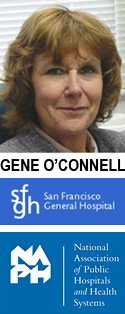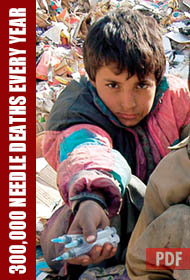Experts Speak Out
Sharps safety has fallen off the radar and there is a complacency to the extent that there will probably be a resurgence in injuries simply because there is no one to strongly advocate [for better technology].
—Mary Foley, RN, MS, PhD, past president, American Nurses Association, Nov. 2010
We know too many health care professionals are still at risk of a sharps injury and that more work needs to be done.
—Karen A. Daley, PhD, MPH, RN, FAAN - President, American Nurses Associantion, Nov. 2010
 By GENE O’CONNELL – RN, MS
By GENE O’CONNELL – RN, MS
Past Chair of National Association of Public Hospitals and Health Systems
Past CEO of San Francisco General Hospital
July 14, 2010
Mr. Jordan Barab
Deputy Assistant Secretary of Labor Occupational Safety and Health
U.S. Department of Labor
200 Constitution Avenue
Washington, D.C. 20210
RE: Bloodborne Pathogen Standard Review, July 2010
Dear Secretary Barab:
I am the former chair of the National Association of Public Hospitals and Health Systems, and was the CEO of San Francisco General Hospital and Trauma Center for over a decade before retiring in March of last year. San Francisco General is one of the nation’s top tertiary academic medical centers and safety net institutions, and has received numerous national awards including the 2008 American Medical Association Ethical Force Programs Awards for its patient centered communications initiative as well as recognition for many advances in emergency care and HIV treatment and research.
It is in everyone’s best interest that the United States has the most up-to-date and innovative technology that fully supports patient and health care workers’ safety.
We must not let the gains of the Needlestick Safety and Prevention Act (2000) fall by the way side, and therefore, I urge updating the Bloodborne Pathogen Standard towards continued oversight in safety, cost-effectiveness, and quality control of all medical devices, otherwise healthcare reform will have missed a valuable opportunity, and in so doing perhaps lead to the evisceration of the Act’s effectiveness.
Internationally, the Needlestick Safety and Prevention Act is the foundation for much parliamentary discussions of healthcare reform. The landmark U.S. legislation is held as the highest standard of humanistic and wisdom-filled governance to ensure patient and healthcare safety, but continued leadership can only be achieved by embracing developments in new technologies. Furthermore, the Act addresses the enormous hidden costs of needlestick injuries to society. Dr. William Maisel, director of Harvard’s Medical Device Safety Instituted, stated the case succinctly in Congressional testimony for healthcare reform that healthcare would improve if we only implement current laws.1
After a decade of implementation, we continue to see hundreds of thousands and perhaps millions of accidents arising from inadequate technology. In the words of Elise Beltrami, medical epidemiologist at Contamination Disease Control, the CDC’s goal is to completely eliminate needlesticks. “We don’t give a time frame for doing that, and clearly it’s going to be a challenge. But with education, training, appropriate device development and implementation, and developing a culture of safety, it’s a potentially realistic goal.” CDC’s national objective can only be achieved by fully supporting the U.S. Needlestick Safety & Prevention Act.
This OSHA review can insure the BPS is updated and given the teeth needed to greatly lessen accidental sticks. Here are some ideas that will improve the OHSA regulations and implementation of the letter and spirit of our laws.
Today, device manufacturers have no responsibility to educate workers and institutions as to technological safety issues and available solutions. The onus has been on the hospitals and laboratories to inform healthcare workers, when in fact it is the manufactures who really know best the issues and problems relative to the technologies they manufacture. Manufactures are making huge profits on small bits of plastic and metal, and they should have a mandated role in the process of lessening accidental needlesticks by insuring users are well aware of the problems inherent in their products.
In 2000, the Act specifically named the then existing ways to improve safety needles: blunting, capping, sheathing, or retracting the needle for injection equipment (syringes,), IV access devices, lancets, and phlebotomy needles. The U.S. Needlestick Safety & Prevention Act proscribes that U.S. manufacturers offer the safest devices available , and it acknowledges that in the future better devices would be invented:
In addition to the existing requirements concerning exposure control plans, the review and update of such plans shall be required to also–
(A) `Reflect changes in technology that eliminate or reduce exposure to bloodborne pathogens’; and
(B) `Document consideration and implementation of appropriate commercially available and effective safer medical devices designed to eliminate or minimize occupational exposure’. (29 CFR 1910.1030(c)(1)(iv)
Since the Act became effective and amended the OSHA Bloodborne Pathogens Standard, dozens of new device technologies are used daily across America, improving safety to both healthcare workers and patients, notably in reducing needlestick injuries and contamination. But we are not out of the woods, as still hundreds of thousands of U.S. healthcare workers continue to receive accidental needlesticks annually not due to their mistaken procedures, but due to technology inadequacies.
The winged needle blood collection set (“butterfly”) is a good example. We continue to see long tubing that requires a third hand to make the procedure safe. Although the market leader announced in 2004 it would discontinue these dangerous ‘conventional’ devices, the fact is they are being used more than ever. The OSHA Standard should require the tubing of these devices be shortened so control of the device will conform to the one-handed safety standard.
I am not endorsing products or companies but shining a light on functions that were not available in 2000. By way of example, market leaders, Greiner Bio-One and Becton-Dickinson, have introduced blood collection needles that inform the phlebotomist of needle placement before insertion of the vacuum tube, the current worldwide standard device used over 3 billion times annually.2 These medical breakthroughs have been developed only in the last few years, like other new technologies including soft tubing in the IV set (reduces the potentially dangerous memory of the collection tubing), and B. Braun’s Introcan catheter that has two safety components on a single device to provide the safety of vein entry indication passively and without major additional cost to the procedure.3 The OSHA regulations should include vein entry indication in the compendium of safety functions.
Research shows that a large percentage of accidents occur during the probing phase in phlebotomy. So, these safety functions represent issues that are responsible for tremendous hidden costs to our healthcare system. In the U.S. alone, multitudes of healthcare workers are exposed to deadly viruses as a result of needlestick and sharps injuries, and before they can return to work, they must test to rule out HIV, Hepatitis, and a dozen other life threatening contagious diseases at cost of $3,000 – $5,000 for each person, costing hundreds of millions of dollars annually simply for testing.4 Amber Hogan, an OSHA expert, summed up the costs to society: “The real and immediate risk of exposure to healthcare facilities include days away from work, medical evaluation and follow up, counseling, emotional distress, side effects from drug prophylaxis, decrease staffing and workers’ compensation costs, to name a few.”5
As Amber Hogan’s article documents, much research has concluded that passive safety is much safer than those components that require manual activation. The BPS needs to reflect this reality in its regulations. Further, OSHA, CDC, and NIOSH should all use the same definition(s) in their respective arenas. Different definitions of the language of safety only confuse the situation, and thereby work against insuring the best technologies are made available in our country.6 These ideas are based on common sense principles that support the evidence based claims of reputable companies that are producing the next generation of safety components.
It is incumbent on OSHA to integrate our best understanding of safety into the decade-old language in order to improve lessening the continued high incidents of accidental sticks and the attendant hidden costs to healthcare. Much has been accomplished in the past ten years, and it is high time for America to reap the rewards of our initial legislation. Please enter this letter into the record of the BPS review, and kindly keep me abreast of progress. Thank you.
Sincerely,
Gene Marie O’Connell, RN, MS
REFERENCES
1 William H. Maisel, M.D. M.P.H, Director Medical Device Safety Institute, Department of Medicine, Beth Israel Deaconess Medical Center, Congressional hearings on healthcare reform June 18, 2009.
2 BD and Greiner Bio-One catalogue materials are clear: It is safer to know needle placement early in the procedure, i.e. the function of vein entry indication. These devices are not readily available in the United States. Note: U.S. healthcare workers know little about the technology problem (eg. Vein entry indication) addressed by these devices.
3 Attached -B.Braun’s literature on the importance of knowing correct needle placement prior to inserting a catheter.
4 Premier Safety Institute, Inc. www.premierinc.com/quality-safety/tools-services/safety/topics/needlestick/index.jsp#Introduction
5 Amber Hogan Mitchell, “Defining Passive in Safety-Engineered Medical Devices,” Virgo Publishing 2009.
6 Ibid.
